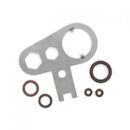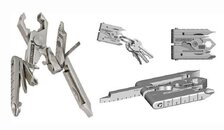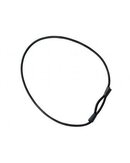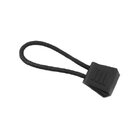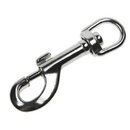Since you're planning on doing Fundies next year, not sure if you have the required equipment list yet, which could be lots to prioritize if you're going to spread out your purchases, and depending on what you already have.
2.2.1.9 (A) Required Equipment for a Fundamentals-Recreational Rating:
GUE Base Configuration (Appendix A)
The GUE base equipment configuration is comprised of:
1. Tanks/cylinders: students may use a single tank/cylinder with a K-, H-, or Y-valve. Students may also use dual tanks/cylinders connected with a dual-outlet isolator manifold, which allows for the use of two first-stages. Consult course specific standards and your instructor to verify size requirements.
2. Regulators:
Single tank: one second-stage regulator must supply a 5 to 7 foot/1.5 to 2 meter hose (2 meter long hose is required for all cave classes). The first stage must supply a pressure gauge, inflation for the buoyancy compensator (BC), and a means to inflate a drysuit where applicable.
Double tank: one of two required first stages must supply a pressure gauge and provide inflation for a drysuit where applicable. The other second stage must supply a 5 to 7 foot/1.5 to 2 meter hose and an inflation source for the BC.
3. Backplate system:
Should be held to the diver by one continuous piece of webbing. This webbing should be adjustable and should use a buckle to secure the system at the waist.
A crotch strap is attached and looped through the waistband so as to prevent the system from riding up a diver’s back.
The continuous webbing should support five d-rings;
o The first placed at the left hip
o The second placed in line with a diver’s right collarbone
o The third placed in line with the diver’s left collarbone
o The fourth and fifth are placed on the front and back of the crotch strap where divers plan to use advanced equipment like DPVs.
The harness below the diver’s arms has small restrictive bands to allow for the placement of reserve lights. The webbing and system retains a minimalist approach.
4. Buoyancy compensation device (BC):
A diver’s BC is back-mounted and minimalist in nature.
It is free of extraneous strings, tabs, or other material.
There are no restrictive bands or restrictive elastic affixed to the buoyancy cell.
Wing size and shape is appropriate to the cylinder size(s) employed for training.
5. At least one time/depth measuring device.
6. Wrist-mounted compass.
7. Mask and fins: Mask is be low-volume; fins are rigid, non-split
8. At least one cutting device.
9. Wet Notes.
10. At least one surface marker buoy (SMB) with spool per diver.
11. Exposure suit appropriate for the duration of exposure.
GUE Standards and Procedures, Version 7.2
86
Additional Course-Specific Equipment
1. Where required, bottom gas, decompression, or stage cylinders are marked in accord with GUE standards and configured in line with GUE protocol. They should be as close to neutral as possible with a relatively small swing from negative to positive during the use of the cylinder.
2. Where argon bottles are applicable, they should be sized appropriately for the environment; small tanks are placed on the backplate with larger supplies affixed to the diver’s left back gas tank.
3. Surface marker buoy: where required, the SMB should be appropriate for environmental conditions and deployed using a spool with at least 100 feet/30 meters of line.
4. One reserve mask is required for some classes.
5. Underwater lights:
Where required, back-up lights should be powered by alkaline batteries (not rechargeable) and stowed on the d-rings at a diver’s chest.
Reserve lights should have a minimal amount of protrusions and a single attachment at its rear.
The primary light should consist of a rechargeable battery pack and be fitted with a Goodman-style light handle.
Where burn time requirements create the need for an external battery pack, it should reside in a canister mounted to the diver’s right hip.
6. Guideline devices, as required during cave diving activities:
A primary reel is required for all cave diving and provides a minimalist form factor with a handle designed to support a Goodman or “hands free” handle operation.
o The primary reel should contain at least 150 feet/45 meters.
A safety spool is required for each diver while cave diving and should contain at least 150 feet/45 meters of line wrapped on a simple spool.
A jump or gap spool is required during Cave 2 dives and should contain at least 75 feet/23 meters of line wrapped on a simple spool.
2.2.1.9 (B) Required Equipment for a Fundamentals-Technical Rating:
GUE base Configuration as outlined in Appendix A, plus:
1. GUE double tank configuration
2. Primary and back-up lights
3. Back-up mask
Prior to the commencement of class, students should consult with a GUE representative to verify equipment requirements and appropriateness of any selected equipment.




